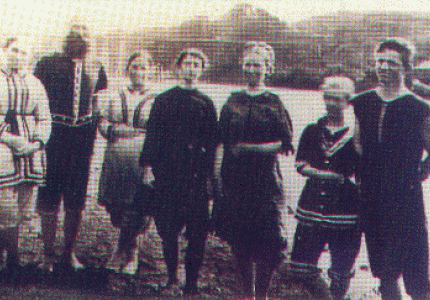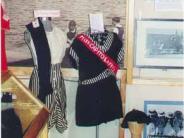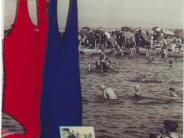By the Sea -- A Century of Swimwear Historic swim apparel
By the Sea, A Century of Swimwear
Exhibit, Summer 1999 Capitola Historical Museum Capitola, CA
Capitola is one spot along the Santa Cruz County coastline that owes its existence, in part, to the evolution of the bathing costume.
Sea-bathing was all the rage in 1869, when S.A. Hall first allowed campers to set up tents at the beach that he rented from Frederick Hihn. A bath house where visitors could exchange their stuffy Victorian clothing for more the more relaxed “aquatic costume†was one of the first buildings Hall constructed when he founded Camp Capitola in 1874.
In celebration of the resort’s 125th year and the role the swim suit has played in its history, the Capitola Museum this summer is featuring a exhibit of swim wear, ranging from the cumbersome Victorian bathing dress to the “let it all hang out†styles of the 1960s. By the Sea, A Century of Swimwear, runs June 12 through Sept. 12 at the Museum, 410 Capitola Avenue. Regular museum hours are noon to 4 p.m. Friday, Saturday, and Sunday.
While the allure of beach life has always been great, the evolution of the bathing wardrobe has been slow. Women vacationers of the late 19th century typically wore black, knee-length, puffed-sleeve wool dresses, often featuring a sailor collar, and worn over bloomers or drawers trimmed with ribbons and bows. Accouterments included long black stockings, lace-up bathing slippers, and caps. Men had swim suits so closely resembling their undergarments that they made the distinction by wearing either black wool or black-with-stripes. The museum show includes a dozen examples of these elaborate but modest and somber wading costumes.
Although a few sea-bathers at Camp Capitola were prosperous enough to appear fashionable in the latest bathing attire, most rented their suits from the bath houses along the Esplanade. In 1890, for instance, the bathers could choose suits to fit figures up to six-foot-two inches in height and seventy-two inches in the waist.
By the turn-of-the-century, bathing suits underwent a revolutionary change in styles as they ceased to be patterned after street wear and began to show a little more of the human form. As contours of shape were no longer camouflaged by yards of fabric, bathers found the exposure was a source of either pride or public disgrace.
Along with the change in design came a shift in function. By 1915, the past-time of sea-bathing—jumping through the waves while holding on to a rope attached to an off-shore buoy—was beginning to give way to the actual sport of swimming. Earnest women athletes did away with skirts and bloomers. They realized that their billowing suits were a disadvantage the men did not share. The heavy fabric interfered with the free play of their muscles, and when wet, could actually drag them down as they attempted to move through water. Eventually, women found it easier to get into the swim of things at the beach if they got to the men’s suits first, sometimes leaving the males with nothing to swim in but a ladies bathing dress.
Other exciting beachwear fine points and swim history trivia to make a splash in this summer’s museum show include the following:
- Bikini-like garb found on a mural in Sicily’s Piazza Armerina shows women at play wearing two piece bikinis in circa 200 A.D.
- Wool swimsuits weighed an average of twenty pounds when wet.
- Richard Cavill invented the Australian crawl swim stroke in 1902.
- Duke Kahanamoku, Olympic champion of 1912, help change styles for swimmers when he appeared in a sleek swimsuit with lighter, bikini-like underdrawers.
- The American Association of Park Superintendents rules from 1917 forbid suits from exposing the chest below a line level with the armpits.
- Jantzen swimsuit company, founded in 1910, introduced its Red Diving Girl logo in 1921.
- Men’s topless suits were commonly worn for the first time in the United States in 1935.
- Santa Cruz surfers in the era before wetsuits searched local thrift shops for vintage wool swimsuits to help them stay warm in the water. “Trunkin’ it,†wearing only trunks while surfing, was not such a good idea along the California coast where the water temperature can range from 43 to 55 degrees.
- Rose Marie Reid used photopermeable fabric in a swimsuit in 1950 to allow full body tanning.
- Brian Hyland’s Itsy-Bitsy Teenie-Weenie Yellow Polka-Dot Bikini climbed the record charts in 1960.






